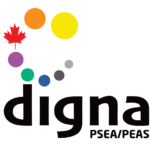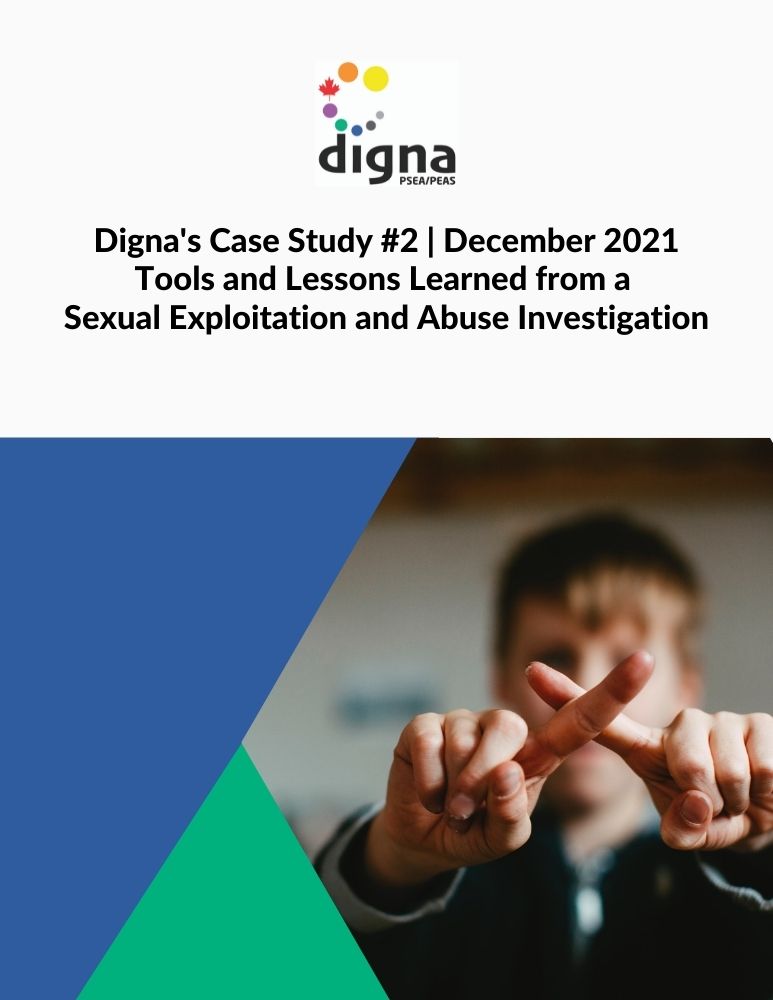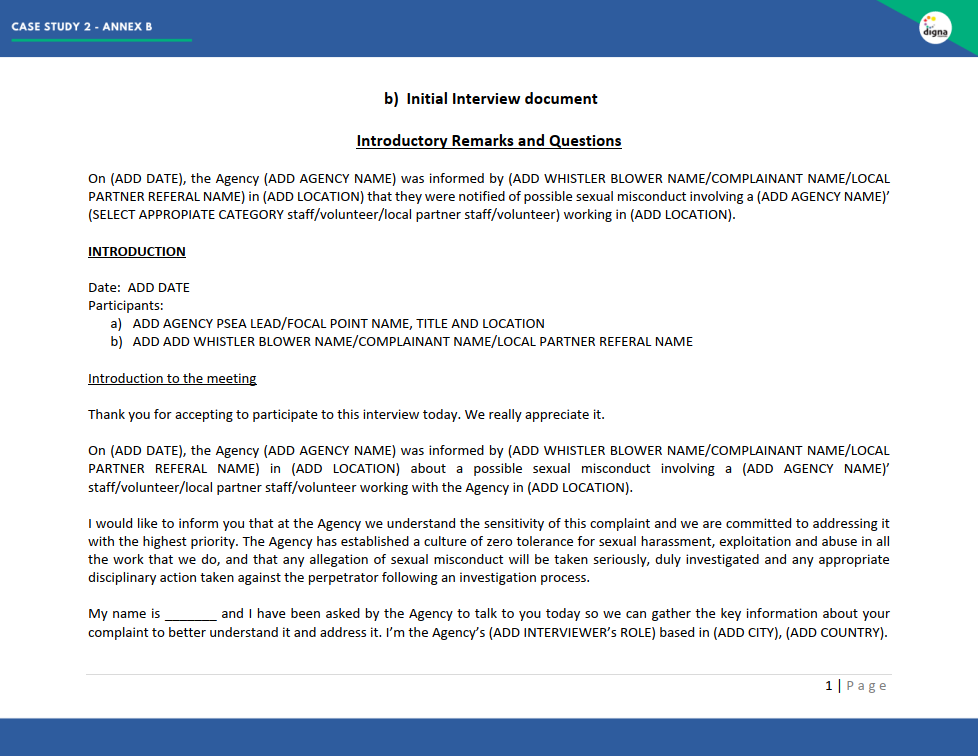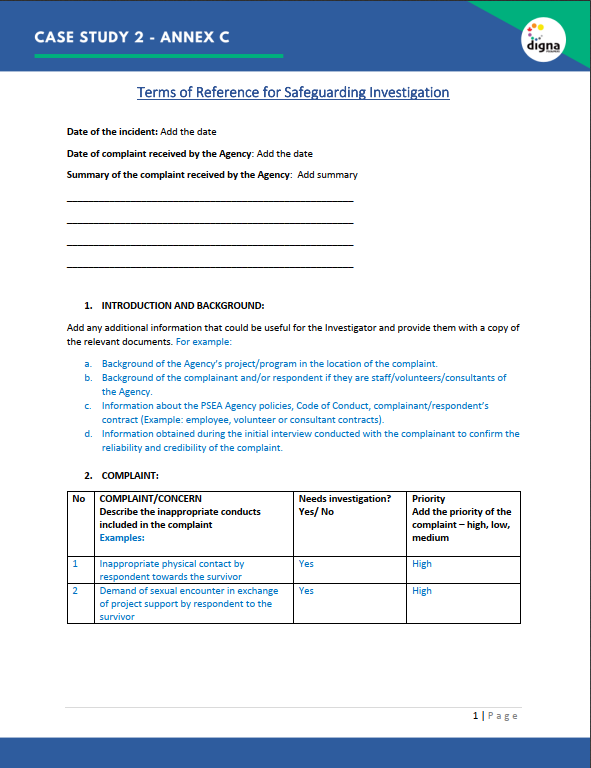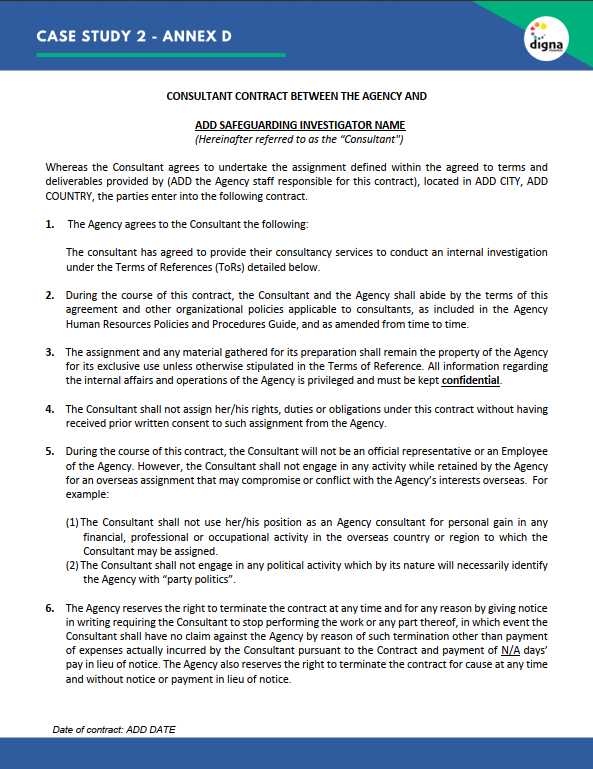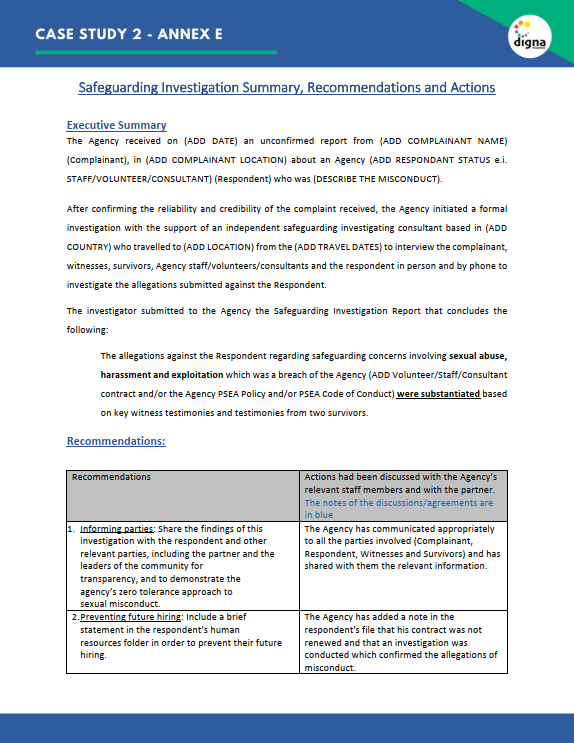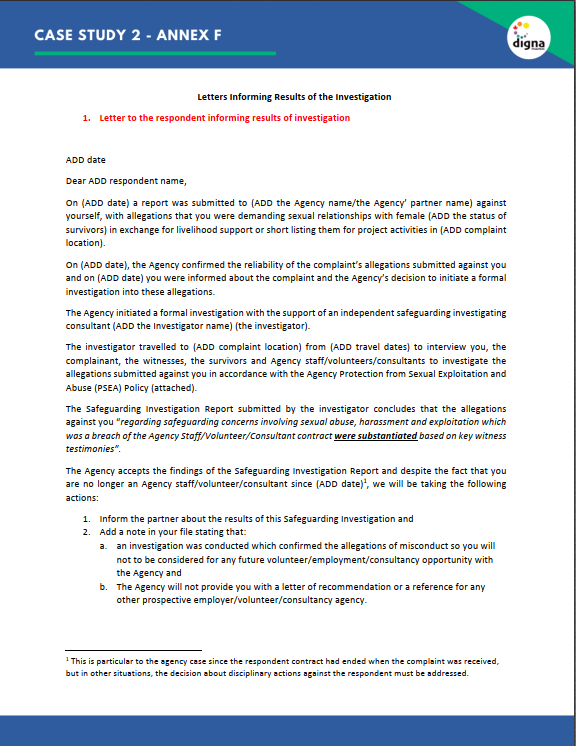Digna's Case Study #2
Tools and Lessons Learned from a
Sexual Exploitation and Abuse Investigation
Tools and Lessons Learned from a Sexual Exploitation and Abuse Investigation
In July, we started publishing a series of case studies developed in collaboration with Cooperation Canada’s membership. The second of this series showcases the experience of an international development agency undergoing a sexual exploitation and abuse investigation.
In this case study, you will find the results of the investigation into an allegation that a community volunteer had been demanding sexual relationships in exchange for livelihood support, or for the inclusion of local community members’ names in project activities and/or benefits. There are some recommendations provided by the SEA investigator, the tools developed during the investigation process, and the agency’s lessons learned.
Tools and Lessons Learned from a Sexual Exploitation and Abuse Investigation
Introduction
An international development agency (hereinafter the agency) delivers projects and programs grounded in a human rights framework and, as an organization, the agency is committed to creating a safe and inclusive culture that allows employees, partners, volunteers, and program participants to thrive. The agency recognizes that sexual violence (1) violates universally recognized international legal norms and standards.
The agency works with the international cooperation sector to ensure a contribution to the collective/shared responsibility to prevent sexual violence. It is for this reason that they are sharing the following PSEA Case Study that reflects their Code of Conduct for Preventing and Responding to Sexual Violence, and their PSEA Policy and Framework. The case study has been anonymized to protect the confidentiality of all parties involved.
(1) Sexual Violence Definition
According to the agency’s PSEA Policy Statement and Framework, sexual violence is defined as “any sexual act, attempt to obtain a sexual act, comment or advance of a sexual nature, or acts aimed at trafficking or otherwise directed against the sexuality of a person using coercion, committed by a person regardless of their relationship with the victim, in any context, including, but not limited to, home and work. Sexual violence encompasses a range of acts including sexual harassment, sexual exploitation, sexual assault and sexual abuse occurring against beneficiaries, staff, volunteers, etc.”
Case Study Summary
In 2020, the agency’s global partner (hereinafter partner) received an unconfirmed report from a local community leader (hereinafter complainant) in one of the countries where the agency operates (hereinafter country). According to the report, an agency community volunteer (hereinafter Respondent) had been demanding sexual relationships in exchange for livelihood support from local community members, or for the inclusion of their names in project activities and/or benefits.
The complainant also alleged that the respondent would only shortlist people that complied with their demands, even when such persons were not eligible or qualified for the program.
During the management of this complaint, the agency took a survivor-centered approach and treated survivors with dignity and respect, had their safety and security as a top priority, and responded to their needs on a case-by-case basis.
After an initial interview with the complainant, and after confirming the reliability and credibility of the complaint received, the agency initiated a formal SEA investigation with the support of an independent safeguarding investigation consultant. The consultant was based in the country and traveled to the specific location where the case was taking place to investigate the allegations submitted against the respondent. As part of the investigation, the consultant conducted interviews (both in-person and by phone) with the people involved, which included the complainant, witnesses, survivors, local staff, and the respondent.
Following the investigation, the consultant submitted to the agency a Safeguarding Investigation Report that concluded the following:
The allegations against the respondent regarding safeguarding concerns involving sexual abuse, harassment, and exploitation, which were a breach of the agency’s Community Volunteer contract, were substantiated based on key witness testimonies and testimonies from two survivors.
Recommendations
As part of the investigation process, the consultant provided a list of recommendations for the agency and the partner:
1. Informing parties
Share the findings of this investigation with the respondent and other relevant parties, including the partner and the leaders of the community for transparency, and to demonstrate the agency’s zero-tolerance approach to sexual misconduct.
2. Preventing future hiring
Include a brief statement in the respondent’s human resources folder in order to prevent their future hiring.
3. Training
All staff and volunteers in the agency’s offices must undertake a standard Code of Conduct and PSEA policy training. To this end, develop a clear plan that includes training dates and continued refreshers.
4. Community Level Participation
The agency’s leadership should provide clear information about policies and procedures, as well as roles and responsibilities of assigned staff known to work with community members, to improve engagement with the local community.
5. Human Resources
Keep a clear recruitment/dismissal Standard Operation Procedures (SoP) for volunteers and outline their supervisors’ responsibilities. Such procedures should be clarified to ensure ongoing awareness of what is happening at the community level, including through measures such as regular supervisory visits, engagement, and communication with community leaders.
Lessons
Learned
- Address PSEA policies and procedures when establishing partnerships: clarify roles and responsibilities, resources available during investigations, and those available to support survivors (medical and psychosocial).
- Ensure PSEA training is made available to staff, partners, volunteers, and community members (Codes of Conduct, policies, procedures, and complaint mechanisms)
- Identify local consultants who can act as investigators and access local resources to support sexual violence cases.
- Establish support from community leaders at the outset to facilitate communications, i.e., conducting interviews, while ensuring privacy and anonymity are maintained.
- Allocate appropriate budget to conduct investigations, and to provide support for survivors, including covering medical expenses.
- Implement efficient mitigation strategies, increasing community participation, and reinforcing the agency’s capacity to manage and respond to sexual violence complaints and investigations.
- Mainstream PSEA in the volunteer and staff recruitment process (position statement in job descriptions, including PSEA questions in reference checks, PSEA self-declaration documents for candidates, which should also be re-stated during interviews, along with the agency’s zero tolerance approach to sexual violence).
- Hold debriefing reviews of sexual violence cases with relevant parties to identify needs for further improvement (i.e. policies, procedures, tools, training).
- Establish communications guidelines that balance transparency and accountability with privacy and confidentiality regarding sexual violence cases.
Tools developed during this Investigation process
The following documents are available and can be downloaded for your reference.
Key information about PSEA complaints (for the agency staff involved in the case)
- Parties involved
- Initial questions
- Immediate actions
- Who needs to know what?
- Roles and responsibilities (table)
- Next Steps
(To confirm the reliability and credibility of the complaint received).
c. Terms of Reference for Safeguarding Investigations
(For investigator)
- Introduction and background of the case and context
- Complaint
- Contract/Policy/Code of Conduct breaches
- Objectives
- Scope and Principles of Investigation
- Proposed Methodology
- Stakeholders and Communication
- Deliverables
- Risk Mitigation Actions/Safety and Security Analysis
e. Safeguarding Investigation Summary, Recommendations and Actions
f. Letters to respondent, complainant, survivors, and witnesses informing results of the investigation
g. Debriefing Session Template
For the investigator, local partner and/or staff members who participated in an investigation process.
A message from Digna
The accompanying annexes are examples from a Canadian organization, for inspiration and adaptation.
Digna urges all organizations to do their own due diligence when replicating examples from other organizations. In all cases, Digna recommends the following:
- It is extremely important to note that only qualified people should conduct an investigation. Investigators should be prepared for potential psychological hazards for themselves and the people they interact with. They should be aware of potential trauma and find ways to avoid retraumatizing respondents, including survivors, as well as, witnesses or other key informants.
- Digna promotes both survivor-centered and trauma-informed approaches to preventing and responding to sexual exploitation and abuse. This means that safety (both physical and psychological) are prioritized throughout the process.
